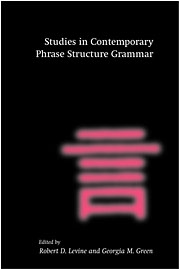Book contents
- Frontmatter
- Contents
- Introduction
- 1 The lexical integrity of Japanese causatives
- 2 A syntax and semantics for purposive adjuncts in HPSG
- 3 On lexicalist treatments of Japanese causatives
- 4 “Modal flip” and partial verb phrase fronting in German
- 5 A lexical comment on a syntactic topic
- 6 Agreement and the syntax–morphology interface in HPSG
- 7 Partial VP and split NP topicalization in German: an HPSG analysis
- Index
2 - A syntax and semantics for purposive adjuncts in HPSG
Published online by Cambridge University Press: 16 December 2009
- Frontmatter
- Contents
- Introduction
- 1 The lexical integrity of Japanese causatives
- 2 A syntax and semantics for purposive adjuncts in HPSG
- 3 On lexicalist treatments of Japanese causatives
- 4 “Modal flip” and partial verb phrase fronting in German
- 5 A lexical comment on a syntactic topic
- 6 Agreement and the syntax–morphology interface in HPSG
- 7 Partial VP and split NP topicalization in German: an HPSG analysis
- Index
Summary
Introduction
The appropriate characterization of the meaning of the preposition “for” has been a recalcitrant problem for theories of syntactic and semantic relations (Fillmore 1968, Platt 1971, Green 1974, Allerton 1982). In this paper, I investigate the semantic interpretation of “for” prepositional phrases in English and examine the parallels that exist between “for” PPs and infinitival purpose clauses. I propose that both “for” PPs and infinitival purposives should be analyzed as adjuncts which introduce a higher-order relation of purpose which holds between the eventuality described by the clause which the adjunct modifies and a potential eventuality introduced by the purposive adjunct itself. The critical difference between infinitival purposives and “for” PPs is that in the former case the eventuality introduced by the adjunct is explicitly described by the adjunct clause, while in the latter case, the nature of the eventuality has to be encoded in the lexical semantics of “for.” I will call these descriptions of eventualities parameterized-states-of-affairs (psoas). I develop an analysis of “for” PPs and infinitival purposive constructions in head-driven phrase structure grammar (HPSG, Pollard and Sag 1987, 1994). This analysis effectively captures the parallels in function and distribution between “for” PPs and purpose clauses. The analysis is further developed to account for NP-modifying “for” PPs and infinitival purpose clauses. The paper is structured as follows. In section 2, I introduce the different interpretations of “for” PPs that I am concerned with and elucidate the parallels that exist between “for” PPs and infinitival purposives.
- Type
- Chapter
- Information
- Studies in Contemporary Phrase Structure Grammar , pp. 80 - 118Publisher: Cambridge University PressPrint publication year: 2000



